This example is an engine exhaust manifold with conjugate heat transfer and structural deformation. The structure is gray cast iron, initially at 300 K. The manifold outer surface has a convective heat transfer coefficient of h = 6 W/m2 K at 300 K. The four inlets to the manifold are held at 500 K with air as the fluid at 5 m/s. AcuSolve passes heat fluxes to OptiStruct. OptiStruct passes the temperatures to AcuSolve. Note that this tutorial is limited to study fluid and thermal domain only.
Model Description
The figure below shows the Fluid structural model used for this tutorial:
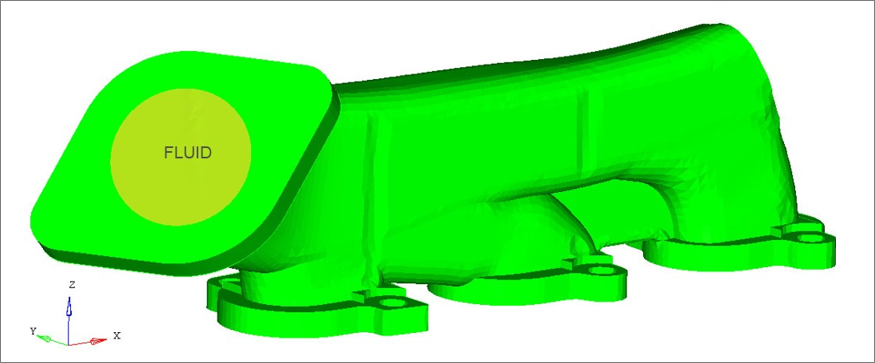
AcuSolve Fluid model (FSI_AS_MANIFOLD.inp) and OptiStruct Structural beam model (FSI_OS_MANIFOLD.fem) files are in the tfsi_models.zip file. Refer to Accessing the Model Files.
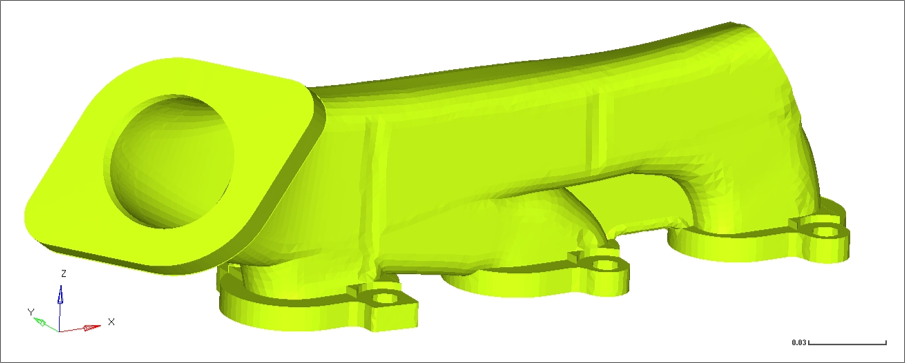
The following exercises are included in this tutorial:
| • | Set up Contact Surface, which is Fluid Structure Interaction surface. |
| • | Set up a Linear Thermal Transient sub-case. |
| • | Submit job and view result |
Exercise
Step 1: Import the model
| 1. | Launch HyperMesh Desktop. The User Profiles dialog appears. |
| 2. | Select OptiStruct and click OK. This loads the user profile. |
| 3. | Click File > Import > Model. |
Step 2: Create Contact Surface
| 1. | In the Model browser, right-click and select Create > Contact Surface. |
| 2. | For Name, enter FSI_Interaction_Surf. |
| 3. | Click Color and select a color from the color palette. |
| 4. | For Card Image, select SURF from the drop-down menu. |
| 5. | For the Elements, click on elements and pick all the internal faces as shown in the below figure. |
Tip: To pick all the elements in the internal face, use the brake angle of 30 degrees.
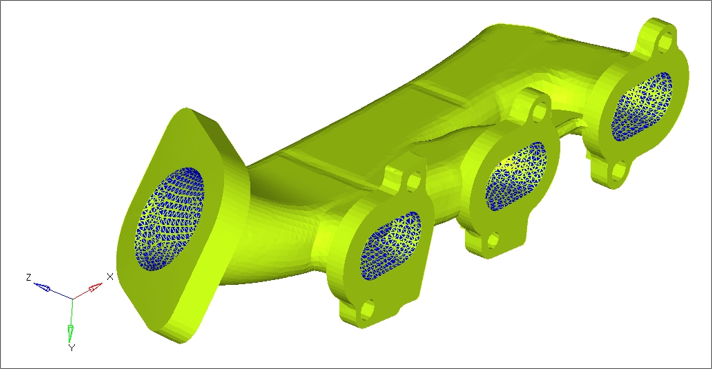
| 6. | Click add to add the faces to the contact surface. |
| 7. | Click return to exit from this panel. |
Step 3: Define Fluid Structure Interaction Parameters
| 1. | In the Model browser, right-click and select Create > Load Collector. |
| 2. | For Name, enter FSI100. |
| 3. | Click Color and select a color from the color palette. |
| 4. | For Card Image, select FSI from the drop-down menu. |
| 5. | Input the values, as shown below. See NLPARM Bulk Data Entry for more information. |
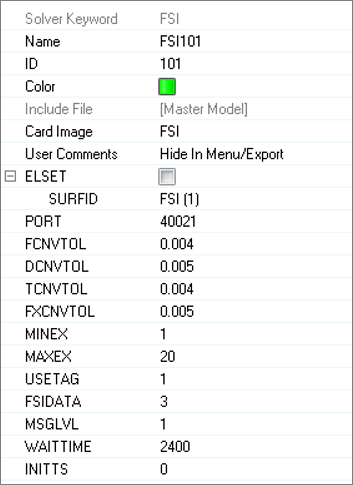
Step 4: Define Output Control parameters
| 1. | From the Analysis page, select control cards. |
| 2. | Click GLOBAL_OUTPUT_REQUEST. |
| 3. | For THERMAL and FLUX, set Option to Yes. |
| 4. | Click return twice to go to the main menu. |
Step 5: Create Transient Heat Transfer analysis subcase
| 1. | In the Model browser, right-click and select Create > Load Step. |
| 3. | Click Color and select a color from the color palette. |
| 4. | For Analysis type, select Heat Transfer (transient) from the drop-down menu. |
| 5. | Input/Select the Load Collector, as shown below. |
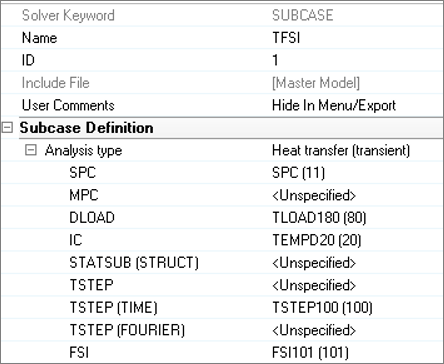
Step 6: Export the OptiStruct Input file
| 1. | From the Analysis page, select OptiStruct. |
| 2. | Click save as and select the directory where you want to write the file. |
| 3. | For File Name, enter FSI_OS_MANIFOLD.fem and click Save. The file extension .fem is necessary for OptiStruct to recognize it as an input file. |
Step 7: Submit the job with HyperWorks Solver Run Manager
| 1. | Launch the HyperWorks Solver Run Manager and select the FSI_OS_MANIFOLD.fem file. |

Step 8: Submit the AcuSolve job with AcuSolve command prompt
| 1. | Open the AcuSolve input file (slab_dcfsi.inp) in a text editor and change the socket_host parameter in the EXTERNAL_CODE block to your machines hostname and save the file. |

| 2. | Open the AcuSolve Cmd Prompt application and enter the command: acuRun-pb FSI_AS_MANIFOLD -np 8 (shown below). |
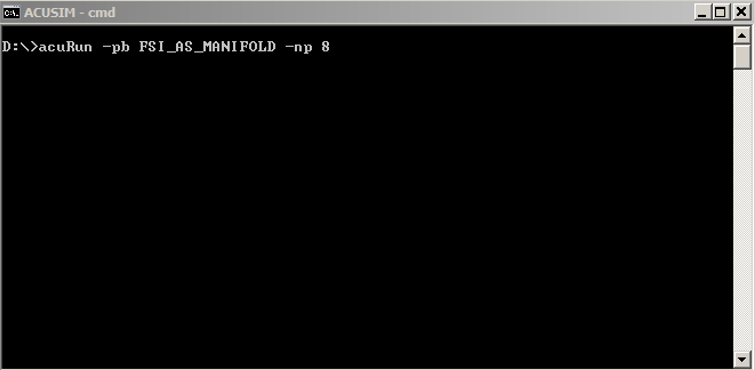
If the job is successful, you will see new results files in the directory where HyperMesh was invoked. The FSI_OS_MANIFOLD.out file is where you will find error messages that will help you debug your input deck, if any errors are present.
The default files that will be written to your directory are:
cci.txt
|
Contains information pertaining to model progression. Logs regarding connection establishment, initial external code handshake and subsequent time step data in conjunction with exchange/stagger.
|
FSI_OS_MANIFOLD.html
|
HTML report of the analysis, giving a summary of the problem formulation and the analysis results.
|
FSI_OS_MANIFOLD.out
|
ASCII based output file of the model check run before the simulation begins and gives some basic information on the results of the run.
|
FSI_OS_MANIFOLD.stat
|
Summary of analysis process, providing CPU information for each step during the process.
|
FSI_OS_MANIFOLD.h3d
|
HyperView compressed binary results file.
|
Step 9: View analysis results
| 1. | Using HyperView, plot the Displacement contour at 1.0 s. |
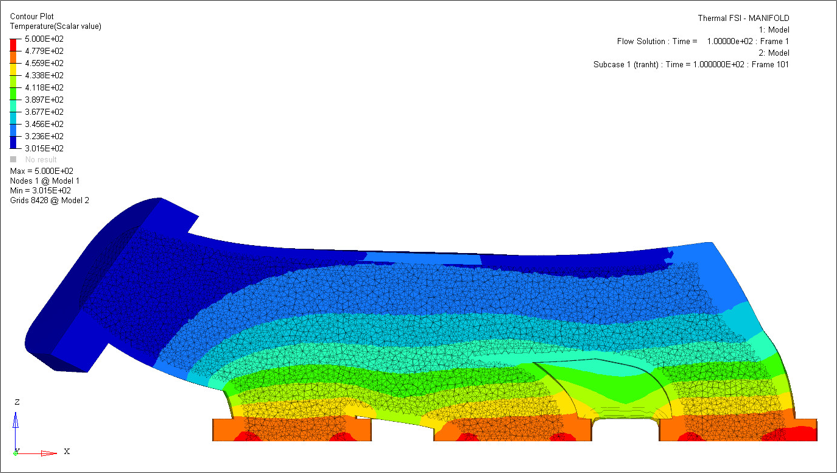
See Also:
OptiStruct Tutorials
Fluid-Structure Interaction

















